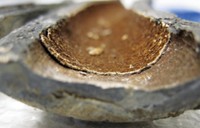Advertisement
Grab your lab coat. Let's get started
Welcome!
Welcome!
Create an account below to get 6 C&EN articles per month, receive newsletters and more - all free.
It seems this is your first time logging in online. Please enter the following information to continue.
As an ACS member you automatically get access to this site. All we need is few more details to create your reading experience.
Not you? Sign in with a different account.
Not you? Sign in with a different account.
ERROR 1
ERROR 1
ERROR 2
ERROR 2
ERROR 2
ERROR 2
ERROR 2
Password and Confirm password must match.
If you have an ACS member number, please enter it here so we can link this account to your membership. (optional)
ERROR 2
ACS values your privacy. By submitting your information, you are gaining access to C&EN and subscribing to our weekly newsletter. We use the information you provide to make your reading experience better, and we will never sell your data to third party members.
Water
Treatment for lead in drinking water is evolving. Will the U.S. EPA catch up?
As regulators look to update controls on lead in drinking water, researchers urge a more holistic approach
by Janet Pelley, special to C&EN
November 21, 2018
| A version of this story appeared in
Volume 96, Issue 47
Tap water from Green Bay, Wis., never exceeded the U.S. Environmental Protection Agency’s lead action level until 2011, when concentrations of the brain-damaging metal suddenly spiked to over 25 ppb. EPA requires drinking water utilities to take steps to cut lead when amounts rise above 15 ppb.

The standard solution for Green Bay, according to EPA’s 27-year old Lead & Copper Rule, should have been simple: Adjust the water’s pH and buffering capacity and maybe add a corrosion inhibitor, such as orthophosphate, to inhibit lead’s leaching from lead-containing pipes, solder, and fixtures.
“However, as an engineer, I wanted to know what went wrong with our system and made it release excess lead after many years of stability,” says Nancy Quirk, general manager of the Green Bay Water Utility.
So she called in Abigail F. Cantor, a chemical engineer with consulting firm Process Research Solutions. Cantor recommended flushing the pipes with a high-velocity stream of water to scour off a crumbly iron-and-manganese scale on pipe walls that was sending lead-laden particles throughout the water system.
The scouring also removed slimy films of microbes that line pipes and affect lead chemistry. Green Bay traced the source of a microbial hot spot in the system to the addition in 2005 of a second supply pipeline bringing Lake Michigan water to the treatment plant, says Andrew Jacque, founder of another consulting firm, Water Quality Investigations. Water sat for longer times in the new pipe than in the old one, boosting the population of microorganisms that coat and corrode water pipes.
Flushing the water mains and supply lines thinned out the microbes while knocking off the scale and helped pull Green Bay’s system back into compliance with EPA’s rule. To institute a more permanent fix, the city is on track to replace all its lead service lines by 2020.
Green Bay’s experience exemplifies a new understanding of the complexity of lead behavior. How best to tame lead releases from water-supply pipes has become a hot topic for cities across the nation making headlines because of their lead problems. It’s also a top concern for EPA, which has signaled that it will revise the Lead & Copper Rule in 2019.
Experts have urged EPA to require complete replacement of lead service lines, as Michigan did this year when it revised its state regulation after the drinking water crisis in Flint. But replacing the nation’s 7 million lead service lines could take decades. Meanwhile, drinking water utilities will still have to control lead corrosion. Accomplishing that will require adaptations in light of new information.
When lead pipes corrode, they release positively charged lead ions into the water. If these ions remain dissolved, they get carried along with water and emerge from taps in homes, schools, and businesses.
Yet some of the lead ions will form new insoluble compounds with oxygen, carbonates, chlorides, sulfates, and other chemicals in the water. If the insoluble compounds form a dense layer on the pipe wall, corrosion will slow or even stop.
Therefore, EPA’s Lead & Copper Rule encourages water systems to tune the pH and buffering capacity of the water to maximize production of insoluble lead carbonates. The rule also endorses the addition of orthophosphate, which forms highly insoluble lead phosphates that coat pipe walls.
But the chemistry of water pipes is not that simple, says Graham Gagnon, an environmental engineer at Dalhousie University. The water also contains disinfectant; inorganic carbon; iron, manganese, and aluminum compounds; and naturally occurring microorganisms and their nutrients—organic matter, nitrogen, and phosphorus. The inorganic components create complex mineral scales that can trap lead on pipe surfaces or promote its release in particles that travel to the tap, depending on scale composition. The microbes form a slimy biofilm on pipe walls that interacts with the pipe and the water.
How microbes affect lead levels in drinking water is an emerging area of research. A lead pipe seems like an inhospitable place for a microbe. But many bacterial species, particularly those found in metal-contaminated soils, tolerate metals, Gagnon says. While some scientists question the role that microbes play in lead release, new research suggests they could be important. For example, some microbes secrete acids that can affect metal corrosion.
And then there’s the organic matter, which naturally occurs in drinking water supplies and is produced by pipe-dwelling microbes.
“The impact of organic material on lead release is grossly underestimated,” Gagnon says. He and his team have examined how lead release is impacted by humic acid, a form of organic matter naturally found in drinking water. In lab experiments, the researchers found that humic acid complexes with and sequesters dissolved lead. That sequestration prevents lead-corrosion reactions from reaching equilibrium, promoting more lead leaching.
Microbial biofilms, meanwhile, incorporate a protective matrix of proteins and polysaccharides that cloaks the microbes. Gagnon and colleagues have also found that polysaccharides and proteins similar to those found in biofilms have a strong ability to bind with soluble lead. “At a mechanistic level, the findings reinforce what Cantor and her colleagues have found in the field,” he says.
Another example of lead behavior deviating from the Lead & Copper Rule paradigm occurred in 1992, when lead levels exceeded the action level in the drinking water of Madison, Wis. Lead concentrations in Madison were highly erratic from home to home, Cantor says. She collected sections of supply pipes and sent them to EPA scientists, who examined the scales. Their analysis revealed that iron from cast-iron water mains and manganese from well water had accumulated onto pipe walls and served as an efficient trap for lead. But the crumbly scale was prone to disintegrate into particles, some of which contained more than 70% lead by weight. The city dropped its lead levels to 3.6 ppb by controlling manganese in its source water, cleaning off aged scales with high-velocity flushing, and removing all its lead service lines—similar to the approach Green Bay is now taking two decades later.
Other water systems are under pressure to add orthophosphate to control lead, to make an extradurable lead-phosphate scale. Water utilities are reluctant to do this, in part because excess phosphate can affect wastewater treatment and drive algal blooms downstream of sewage plants. Research is also starting to show that the orthophosphate approach may also not work to control lead as well as advertised.
In one study, EPA researchers analyzed pipes from a drinking water system using blended-phosphate corrosion inhibitors. Instead of solid lead phosphate on pipe walls, however, the scientists discovered a porous, amorphous layer rich in aluminum and calcium as well as lead and phosphorus. Amorphous scales may be vulnerable to breaking away from the pipe because of physical or chemical disturbances.
Orthophosphate may also fail to block lead’s leaching caused by galvanic corrosion, other studies suggest. Galvanic corrosion occurs when two dissimilar metals come in contact with each other, such as when lead pipes or solder contact copper pipes. Scientists in Canada and the U.S. have found that orthophosphate does not reduce lead release related to galvanic corrosion and may instead accelerate it.
Other research has shown that when some utilities start dosing with orthophosphate to cut lead levels, dissolved lead levels drop almost immediately—while it can take six months or more for particulate lead levels to decline. Yet other studies suggest that higher doses of phosphate can actually increase water contamination with particulate lead.
These results prompted engineers Daniel Giammar of Washington University in St. Louis and Yandi Hu of the University of Houston to investigate what makes lead phosphate particles stick together and adhere to pipe walls or break apart. Hu’s lab has found that the addition of excess phosphate causes lead phosphate particles to become negatively charged, so they repel each other and resist aggregation.
“Although the addition of excess amounts of phosphates can lower dissolved lead concentration, it could result in higher particulate lead levels in tap water,” Giammar says.
The growing consensus is that water utilities need to study their particular system to determine optimal treatments rather than counting on simple solubility equations.
EPA’s guidance on the current Lead & Copper Rule “contains nice flow diagrams that you follow like a cookbook, but I tell my clients that they have to stop doing this because there is no one-size-fits-all solution,” says David A. Cornwell, president of consulting firm Cornwell Engineering Group. “Don’t just switch to orthophosphate without doing sufficient studies beforehand because you don’t know what’s going to happen, and you could disturb the chemistry of your pipe scales and make things worse,” he says.
Advertisement
The recent lead crisis in Flint, Mich., is the poster child for what happens when regulators don’t look at the big picture, Cantor says. When the city switched water sources to the Flint River, the water chemistry changed. The river water destabilized old scales and introduced more nutrients and microbes into the distribution system.
But the lure of an ostensibly simple solution remains strong. When Michigan updated its state regulations in June, it addressed shortcomings in water sampling and mandated removal of lead pipes but left corrosion-control guidelines largely alone.
And EPA might not do much better at the federal level. As it looked ahead to updating its Lead & Copper Rule, last year the agency floated a proposal that would require all water systems to use the same corrosion-control treatment. That approach could risk unintended consequences, such as increased lead release from destabilized pipes or phosphorus nutrient loading to rivers, Quirk says.
A better way forward to protect public health, she says, is to use new research that takes a more holistic perspective of pipe systems and their complex chemistry.
Janet Pelley is a freelance writer based in Victoria, British Columbia.





Join the conversation
Contact the reporter
Submit a Letter to the Editor for publication
Engage with us on Twitter